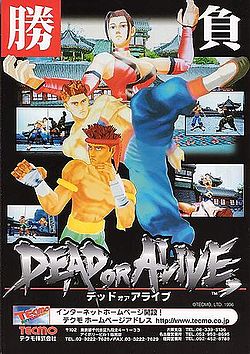- Dead or Alive (arcade game)
-
Dead or Alive 
Developer(s) Team Ninja Publisher(s) Tecmo Designer(s) Tomonobu Itagaki Platform(s) Arcade, Sega Saturn, PlayStation Release date(s) Arcade
1996
Sega Saturn
- JP October 9, 1997
Genre(s) Versus fighting Mode(s) Up to 2 players simultaneously Rating(s) Saturn/PlayStation ports:
ELSPA: 11+
ESRB: T
USK: 16+Cabinet Upright Arcade system Sega Model 2 Display Raster, 496 x 384 pixels (Horizontal), 8192 colors Dead or Alive (デッドオアアライブ Deddo oa Araibu) is a fighting game and the first entry in the long-running Dead or Alive series. It was released in 1996 in arcades, followed by home ports for Sega Saturn in 1997 (Japan only) and Sony PlayStation in 1998 (all regions).
Contents
Gameplay
Dead or Alive was unique in its debut that featured fairly different choices in gameplay than other 3D fighting games. Its most defining features were its speed and countering system. Dead or Alive put an emphasis on speed, and relied more on simplistic commands and reaction time. Furthermore, its countering system was the first in the fighting genre to utilize different commands that corresponded to each type of attack. There are two kinds of holds, an Offensive Hold (OH) and a Defensive Hold (DH), furthermore, these commands are executed by holding back or forward on the directional pad along with the guard input to either force away or counter-damage an opponent. Finally, the game used an environmental addition called the Danger Zone, which surrounded the outer edges of the fighting arena (depending on the options, it could also completely consume it), and when a character came in contact with it, sent them in the air so the opposing player can execute a juggling air combo. However, this can be avoided with a Ukemi (defensive roll).
Story
Character roster: Ayane (PlayStation and ++ version only, Kasumi's half-sister), Bass Armstrong (PlayStation and ++ version only, Tina's father), Bayman, Gen Fu, Jann Lee, Kasumi, Lei Fang, Raidou (boss character, unlockable, Ayane's father), Ryu Hayabusa, Tina Armstrong, Zack.
Development
Tomonobu Itagaki has stated that he was dissatisfied with the way modern fighting games were presented, he missed the old arcade style of play and had another vision for the fighting game genre. Having worked for Tecmo for a long time, Itagaki was eventually given the opportunity to develop a fighting game. The game, the first Dead or Alive, was released in 1996 as an arcade game for the Japanese market. It had been a success in Japan, but not in the West. This was possibly because of the competing game Tekken, which was already a popular fighting game series for the PlayStation.
Versions
There are three different versions of the original Dead or Alive.
- The original version of Dead or Alive was released in arcades in 1996, utilizing Sega's Model 2 arcade board[1] (it was also the first time Sega licensed their hardware to a third-party company; in this case, Tecmo). It was later ported to the Sega Saturn in Japan on October 9, 1997. The game was never released for the North American nor European Sega Saturn. It was released in the United States and Europe for the Xbox on October 26, 2004 and February 18, 2005, as part of Dead or Alive Ultimate (see below).
- On March 12, 1998 in Japan, Tecmo released Dead or Alive for the PlayStation. This version included 2 new characters (Bass & Ayane), a different graphics engine, a slightly revamped fighting engine and new background music (BGM). The PlayStation version was released in North America on March 31, 1998, and later in Europe on July 1998.
- In 2004, Tecmo released a revamped version of the Sega Saturn version on the Xbox along with an updated version of Dead or Alive 2 in the same package. It was basically the original game ported to the Xbox, making graphics more colorful and smoother, sound from stereo to surround, and adding Xbox Live Online Gaming. This game along with Dead or Alive 2, Ultimate became the second fighting game with online play.
The original game, which ran on the Model 2 arcade board, had fully 3D modeled backgrounds. The Sega Saturn conversion used bitmap tricks and overlapping layers in the same fashion as the Sega Saturn version of Virtua Fighter 2 did. The original arcade used pure 3D on all the arenas. It was impossible to achieve this on Saturn hardware and the game was scaled down. Dead or Alive also received some added notoriety for having the breasts of its female characters animate independently of their bodies, bouncing up and down wildly as the women jumped and moved. While seemingly a silly, disposable novelty at the time, this actually became - and still remains - a trademark of the series, though it has been more realistically implemented as technology has allowed.
Reception
References
- ^ "The History of Dead or Alive". IGN. 02-08-2004. http://uk.xbox.ign.com/articles/535/535283p1.html. Retrieved 2007-10-08.
External links
Dead or Alive series Main series Xtreme series Other games Characters Related media Categories:- 1996 video games
- 3D fighting games
- Arcade games
- Dead or Alive
- PlayStation games
- Sega Saturn games
- Versus fighting games
- Xbox games
Wikimedia Foundation. 2010.
